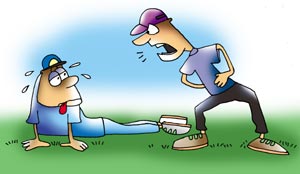
The Test series between India and Pakistan is now history. But up next are the one-day internationals, where now only the players will be tested mentally and physically.
All that has happened must be forgotten for the moment and somehow, the Indian team needs to to lift itself mentally for the ODIs. Physically, though, things seems to be in a much better state. All the hopefuls are in injury free and look all set to remain that way.
Senior Cricket Correspondent Ashish Magotra spoke to the Indian team's trainer Gregory Allen King to find out the secret of the Indian team's fitness.
How different is the Indian physique from say an Australian or a West Indian. Does it react differently to exercise?
Considering I have not worked hands on with many Australians or West Indians if is difficult to make an accurate comparison. I can make generalizations though. It would appear that Australians and West Indians tend to have a naturally larger frame and also tend to be more muscular.
In the case of the West Indian players it is noticeable that they also tend to have lower body fat percentages. In terms of how the body reacts to exercise, all humans adapt to the stress imposed on them in a similar manner. This adaptation is specific to the stress imposed (type of exercises), underlying genetic differences (ie predominant fiber type) and the manner in which the individual recovers after the stress (nutrition, sleep, etc).
This is a very simple way of answering the question but basically human physiology is the same across race or ethnic differences. So if an Indian athlete were to perform the same exercise their body would basically respond the same as that of an Australian or a West Indian.
At what age should a young cricketer start weights?
It is always important to remember that cricket is first and foremost a game of skill so I always feel that it is important for young cricketers to ensure that they have got the requisite skill levels before they get too carried away with weight training.
Another aspect of conditioning the young athlete is the principle of specificity, basically this means that the best form of conditioning for cricket is actually playing or practicing cricket. Don't get me wrong it is obviously important for any athlete to have good general levels of fitness as these will compliment his performance.
However, fitness training can never make an average cricketer into an excellent one, but it will definitely make a good cricketer even better. Now to actually answer the question of when (at what age) should young cricketers' start strength training? I do not feel there is a definite age that all young cricketers must start strength training it is important to look at each player individually and see his physical and mental level of maturation.
Although provided a player participates in a safe and well-structured strength program most cricketers could start strength training at around 15-16 yrs. Again though this is a key period for the development of skills soothe strength program should never be given more importance than the skill development.
Are there any specific exercises for batters and bowlers?
Yes. Some of the drills that we use to specifically condition the batters involve various forms of shuttle runs. This is specific to the type of running activity that batters undergo whilst batting.
For bowling we prescribe many different exercises to help strengthen the core stabilizers (muscles that are important for stabilizing the pelvis and spine whilst bowling).
However as mentioned earlier the most specific exercise a batter can do is to spend time batting in the middle and similarly for a bowler it is to bowl. There are many different exercises that we give the players to help them improve general conditioning.
Let's say, the average bowler gets through 1000 overs a year. Can injuries be prevented or are they just part and parcel of a fast bowlers career.
If a bowler bowls too many overs there is very little that one can do to prevent them from getting an injury. In any sport if you put sufficient stress on the body it will eventually get injured. Since no two players are alike, the trick is to carefully monitor each player closely to try and prevent injuries.
One bowler may be able to sustain a much greater workload than another for no other reason than individual differences. So we need to try and observe the players und reduce their workload when it appears as if they are becoming too fatigued.
Shoulder injuries, back injuries, foot injuries - fast bowlers seem to be more susceptible than batsmen or spinners. Myth or fact?
The very nature of bowling fast requires a player to put their body under a great deal of stress. The forces imposed on the body when bowling fast are far greater than when bowling spin and it is no surprise that fast bowlers tend to be injured more frequently.
Illustration: Uttam Ghosh







 © 2025
© 2025